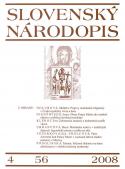Mariánske motívy v tradičných žánroch: legendické piesne a maľba na skle
Marian Motifs in Traditional Genres: Songs-Legends and Paintings on Glass
Author(s): Hana UrbancováSubject(s): Anthropology
Published by: Ústav etnológie a sociálnej antropológie Slovenskej akadémie vied
Keywords: Marian cult; genre; theme; iconography;
Summary/Abstract: In Slovakia, Marian motifs represented in folklore genres and in folk visual arts are to be found in many examples. On the one hand, they appear in a wide range of types and their varieties, on the other, they are mutually intertwined. A comparative research study has focused on a parallel existence of narrative themes and pictorial representations in songs-legends and paintings on glass. However, this parallel occurrence was not linked to the direct takeover of stimuli from the other genre or medium, but to the awareness of the existence of a particular story or picture. A comparison of themes presented in both of the genres has yielded evidence that a sung legend and a painting on glass did not develop in isolation but against a common background established by Christian tradition and folk belief. Common themes form only a limited selection of subjects and topics into which key events of the Marian cycle are incorporated. They are complemented by the key motif of Crucifixion from Christological cycle although this has been treated differently by either medium. It has also been proved that such themes, which developed in songs-legends into clearly identifiable subject-matters and in paintings on glass into a set of topics, are only complementary. This stems not only from the thematic structure and the way of rendering of commonly shared themes, but also from the emphasis they put on the specific character of the themes presentation, depending on the differences between the media and the specific means of expressions they employ. Marian motifs in songs and paintings are manifested in relations of the folk version to the model drawn from visual arts and literature. While being taken over and adapted to the traditional environment the models receive treatment according to the reduction principle. That means that the model goes through a phase of the “grinding-off” of all elements which are considered by the anonymous authors unimportant and which do not affect the addressees of their work. They thus reflect a different mentality of the traditional environment which transforms the model to a version respecting the taste, thinking and feeling of this environment. The song-legend is based on a narration of a story with some religious content. The narrative style is also used in paintings on glass depicting some of the events of the Marian and Christological cycle. The subject-matter of the paintings on glass is the Virgin Mary represented as an iconographic type of meditative character. These representations are also projected into songs-legends; standing in the background of the narratives they reveal themselves in the Virgin Mary´s acts. The reciprocity of these images also manifests how the genres and the media get united and also how the Marian cult rendered in more complex forms is received in a traditional environment.
Journal: Slovenský národopis
- Issue Year: 56/2008
- Issue No: 4
- Page Range: 399 - 417
- Page Count: 19
- Language: Slovak

